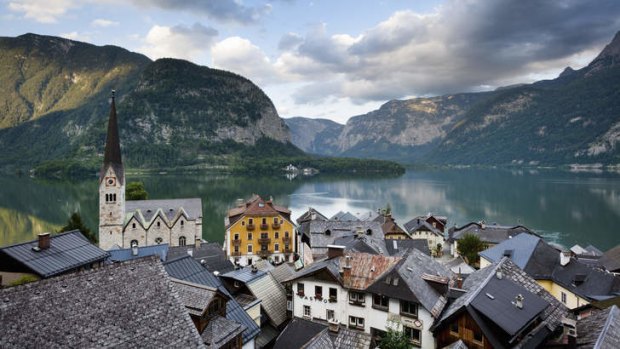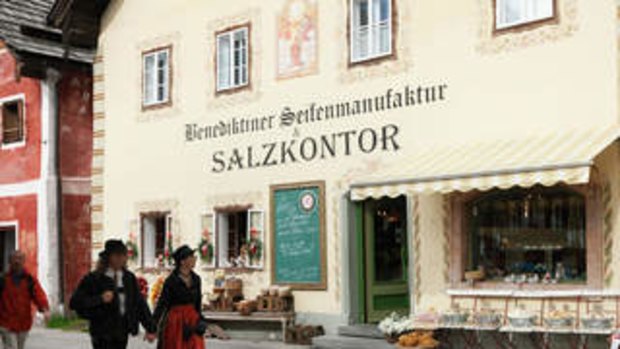
Hallstatt and Lake Hallstatt.Credit: Getty Images
Helen Anderson buttons up and explores the beauty and revived traditions of the Salzkammergut alpine region.
Another sharp intake of breath, another attempt at closure. Perhaps it's the wrong size? "No, no, it will fit. You must have va-voom!" Birgit insists cheerfully, and in one uplifting gesture she shows how the marvellous engineering of her own straining bodice over a low-cut white blouse and push-up foundation garment has created a decolletage with traffic-stopping potential.
More giggling, a bit more sighing and fiddling and I'm buttoned-up in all the right places - a dirndl for a day. This is the term for the woman as well as the traditional outfit worn in alpine regions of Bavaria, Austria, Switzerland and South Tyrol in northern Italy. The dirndl ensemble is usually a white blouse with puffed sleeves, a snug-fitting bodice attached to a full skirt and topped by an apron, though there are regional and seasonal variations and versions for special occasions. The ultimate accessory is a chap in embroidered lederhosen, with braces, loden jacket, long socks and hat.

Hallstatt, built on the world's oldest salt mine, has a salt shop.Credit: Alamy
Outside the German-speaking world there's a common misconception that trachten (the generic term for women's dirndl and lederhosen for men) are fancy-dress costumes, worn most often by robust girls serving beer during Oktoberfest. In this part of Austria, however - in the spectacular central alpine region of Salzkammergut - it's everyday gear worn from supermarket to theatre, from breakfast to Beisl, and by men and women of all ages. And even by those, such as me, who fancy a dabble in a dirndl.
So from the changing rooms of Dirndl to Go, a business opened in mid-2012 by Claudia Holl and Birgit Lupert, a group of travelling dirndls emerges on the cobbled lanes of Hallstatt, perhaps the prettiest village in Austria.
The swashbuckling 19th-century explorer Alexander von Humboldt declared Hallstatt "the loveliest lake village in the world"; so heartwarmingly, perfectly pretty that a "Made in China" replica of this village of 950 souls has been constructed near the industrial city of Huizhou in southern China.
Opened in June, the notion of this part-residential, part-theme park knockoff met with mixed reaction from the residents of the real village. The replica steeples, gabled roofs and perfectly tended window boxes might resemble the real versions, but the ersatz village cannot approximate this sublime setting, wedged between towering mountains and a deep, mirror-still lake. "I have yet to see a place as strangely situated as Hallstatt," wrote doctor and travel writer Franz Satori in 1813, though little has changed in 200 years. "The houses seem to sit upon each other, built as they are on the sloping narrow bank, clinging like swallows' nests and reflected in the enamel green of the lake." He failed to mention something stranger still: the village sits atop a salt mine - the oldest and, quite possibly, prettiest salt mine in the world.
Helga Lenz, a long-time resident and guide, is wearing dirndl, of course, as she strolls with us around her village explaining its long and rich history of salt miners, traders and aristocratic travellers. We sashay along the lakeshore to the market square with a waterfall tumbling almost overhead, to a steepled stone church with tiny cemetery and, perhaps, the world's least spooky charnel house. In Hallstatt, even an ossuary full of painted skulls is somehow pretty.
Young women in dirndls climb cobbled lanes with their shopping, walking their dogs, pushing prams. In their presence, my transition from awkward impostor to just another fraulein with an instant hourglass figure is swift and natural.
After a spin around the village in bodice and apron, a couple of hours in the salt mine is obligatory. It begins with a spectacular funicular ascent from the village, then an interpretive walk through meadows to the mine entrance. From here, it's a family-friendly adventure: a salt-miners' train to a subterranean salt lake, 7000 years of history neatly interpreted and swift descents on two wooden slides, just like the miners once used. Never in history has a day in a salt mine been so much fun.
Surrounding Hallstatt is the World Heritage-listed Dachstein region, Austria's lakes district: immortalised in The Sound of Music, the heart of traditional handcrafts (and arguably Austria's finest trachten), loved by emperors and adventurers for superb hiking, climbing, skiing, and swimming among the mountains and more than 70 lakes.
A perfect day starts in picture-perfect Hallstatt when the church bells ring and the sun clears pine-clad mountains above the village. From where I stand, on the balcony of a 14th-century stone hotel, the lake is so green and glassy I can clearly see the wake of a single paddling duck.
En route to the imperial spa town of Bad Ischl, we stop at Hand.Werk.Haus in Bad Goisern, where 16 master artisans have workshops. "It's about authenticity, sure, but also about cultural identity and the future," says historian and workshop guide Barbara Kern, pointing out fashion-forward spectacles carved from staghorn, a fifth-generation hatter and heirloom lederhosen that took 120 hours to sew.
It's time for coffee and zaunerstollen at the Belle-Epoque cafe Konditorei Zauner when we arrive in Bad Ischl, and as Friday is market day we're joined by crowds of ladies in dirndl and chaps in lederhosen. This segues into lunch at the celebrated Goldenes Schiff by the Traun River: tafelspitz, a refined version of the much-loved dish of boiled beef in broth and horseradish (into which I grate local rock salt) and kaiserschmarrn, everyone's favourite pancake dessert.
By early afternoon, we're winding through glorious peaks near Loser and on to Lake Altaussee. This is quintessential Austria: majestic limestone mountains reflected in deep drinkable water. Heinz, a gentleman wearing vintage lederhosen and a fine felt hat, oars us across the lake in his traditional wooden boat.
Behind us, the sun is shining on the white mantle of lofty Dachstein; in front, a pair of swans waddle away imperiously as we pull up at an old hunting lodge. Framed by spruce and mountains, Jagdhaus Seewiese has a fairytale setting for a meal of lake char and a glass of Gruner Veltliner, served by a gorgeous blonde girl - proudly wearing lederhosen.
FAST FACTS
Getting there Emirates has a fare to Vienna/Munich from Sydney and Melbourne for about $2085 low-season return, including tax. Fly to Dubai (about 14hr) and then to Vienna (6hr 5min) or Munich (6hr 35min); see emirates.com. This fare allows you to fly via another Asian city and to fly back from another European city. Australians do not require a visa for tourism for an accumulative stay of up to 90 days in a six-month period in the Schengen States.
Hallstatt is about three hours' drive from Vienna and from Munich. Or detour on the 380-kilometre "Romantic Road" between Vienna and Salzburg. See romantikstrasse.at. Hallstatt is traffic-free; cars are parked on the outskirts of the village and a shuttle bus transfers overnight guests. Or connect to Hallstatt on the scenic Vienna-Salzburg train; the train stops on Hallstatt Lake's eastern shore, from where ferries take passengers to the village.
Touring there
Dirndl to Go in Hallstatt fits and rents outfits for €22 ($28) for the first hour, €35 for a half-day; see dirndl-to-go.at. The Heritage Hotel Hallstatt offers a dirndl and dinner package.
The salt mine, Salzwelten Hallstatt, is open April 20-October 27, 2013. Tickets include return funicular ride from Hallstatt and a guided 70-minute tour of the mine with protective clothes provided; adults €7, children 4-15 years €3.50, family €15; see salzwelten.at.
The Salzkammergut region is a year-round destination, with superb hiking, mountain-biking and climbing in summer; affordable snow sports (even ice-diving) in winter. There's skiing on more than 60 kilometres of slopes from December to May in 19 resorts; Dachstein West, Tauplitz and Krippenstein are among the most popular.
Staying there The Heritage Hotel Hallstatt has four-star rooms and suites in three converted village properties, including a stone home dating from the 14th century. Double rooms with breakfast cost from €179; see hotel-hallstatt.com.
More information hallstatt.net; salzkammergut.co.at
Donning a dirndl: frompeasant to Pinterest
"IF EVERY woman wore a dirndl, there would not be any more ugliness." There are few fashion statements on which British designer Vivienne Westwood and I are aligned, but after a day in a dirndl and much observation of the traditional outfit in its native habitat, I tend to agree.
Along with lederhosen for men, the traditional outfits, also known as trachten, have been the subject of repeated reinterpretation, from the modest gear worn by alpine peasants to aristocratic fashion statement in the 19th century, from post-World War II political symbols of nationalism and ultra-conservatism to idealised von Trappism in The Sound of Music — and to Pinterest mixing dirndl tradition and ironic deconstruction.
Austrian snow and surfwear company Blue Tomato created boardshorts resembling lederhosen this year. Austrian designer Othmar Schmiderer has styled lederhosen for gals with high heels, dirndl embossed with skull and bones and stylised as kimonos. Designer Gabriela Urabl's Dirndlherz label, with a shop in Vienna's chic seventh district, has an "African Queen" dirndl, a "cross between American Apparel and Disney's Snow White with a Senegalese touch", according to The Vienna Review. And dirndl skirts have been seen recently on catwalks in London and Paris.
Almdudler, the revived Austrian soft-drink manufacturer, has a retro trachten-clad couple on its label and sponsors the first Viennese ball of the season, in September, where the young and beautiful wear dirndl and jackets with antler buttons and dance to international DJs.
In a summer of "dirndl temptation" across Manhattan in 2012, the Austrian National Tourist Office encouraged local dirndl and lederhosen "ambassadors" to truss up and promote the best of Austria in New York City.
The campaign has shifted hemispheres, with public events in Sydney from February 17 until late March. For updates see dirndl.austria.info.
Helen Anderson travelled courtesy of Emirates and the Austrian National Tourist Office.
Sign up for the Traveller Deals newsletter
Get exclusive travel deals delivered straight to your inbox. Sign up now.